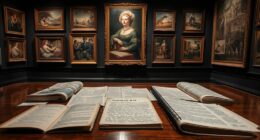Understanding exhibition design means recognizing how it's crucial for shaping visitor experiences. It combines creative storytelling, clear objectives, and tailored strategies to engage diverse audiences. You'll notice that effective planning guarantees a smooth visitor journey, while high-quality content makes a lasting impact. Accessibility and inclusivity are also essential, providing enjoyable experiences for everyone. Incorporating design best practices, like logical flow and inviting signage, enhances interaction. Ultimately, exhibition design transforms content into immersive explorations that resonate with you. If you're curious about how to implement these strategies, there's much more to discover about creating successful exhibitions.
Key Takeaways
- Exhibition design influences visitor engagement through immersive storytelling and well-defined objectives aligned with the museum's mission.
- Effective planning includes optimizing visitor routes and utilizing promotional campaigns to enhance audience participation and drive attendance.
- Accessibility and inclusivity are vital, incorporating features like ramps, high-contrast colors, and multi-sensory engagement for diverse learning styles.
- Clear signage and structured wayfinding systems enhance navigation, leading to a more enjoyable visitor experience and reducing congestion.
- Detailed budgeting and cost management, including the use of tools and community insights, are essential for successful exhibition outcomes.
Importance of Exhibition Design

Exhibition design is essential because it directly influences how effectively you communicate messages and engage visitors. As an exhibition designer, your role goes beyond aesthetics; it involves crafting immersive storytelling elements that resonate with the audience.
A well-defined exhibition brief is imperative for project success, ensuring you outline objectives and learning outcomes that keep your focus sharp during development.
Understanding your target audience's interests and learning styles is fundamental in creating a meaningful visitor experience. By integrating various design disciplines—architecture, graphic design, and lighting—you can enhance the impact of your exhibitions, making them memorable and engaging.
The growing influence of social media also plays a significant role in this process, as it amplifies the importance of visual representation, allowing visitors to showcase their experiences and connect with personal identity and cultural significance.
Ultimately, effective exhibition design transforms a simple display into an interactive journey, fostering lasting memories and encouraging meaningful interactions. When you prioritize these elements, you not only engage visitors but also elevate the entire experience, ensuring your exhibition leaves a lasting impression.
Objectives and Visitor Engagement

When you set clear objectives aligned with your museum's mission, you guarantee that the exhibition effectively communicates its key messages and values to visitors. These objectives serve as a foundation for your exhibit design, ensuring that every element contributes to a cohesive narrative.
Engaging visitors through targeted audience takeaways shapes how you design features and spatial storytelling, considerably enhancing their overall experience. Additionally, applying principles of Cultural Intelligence can help tailor your exhibition to resonate with diverse audiences, fostering inclusivity and engagement.
Using a master plan to outline visitor routes and logical content sequences creates a structured flow that guides guests effortlessly through the exhibition. Recognizing diverse visitor interests and classifying audiences into groups allows you to implement tailored design strategies, catering to varying levels of expertise and engagement.
This personalized approach fosters deeper connections and encourages active participation. Incorporating effective advertising graphics and shareable moments can considerably boost public engagement and attendance.
Planning and Marketing Strategies

When you're planning an exhibition, optimizing visitor routes is key to guiding them through your content effectively.
You'll also want to craft effective promotional campaigns that resonate with your target audience and drive attendance.
Visitor Route Optimization
To enhance the visitor experience, optimizing the route through an exhibition is essential. A well-planned visitor route optimization not only guides attendees through a logical sequence but also elevates storytelling and engagement.
Here are four key strategies to take into account:
- Master Plan Development: Create a thorough layout that logically guides visitors from one exhibit to the next, enhancing their understanding and enjoyment.
- Clear Signage: Implement effective wayfinding systems to reduce confusion. This guarantees visitors can easily navigate through the exhibition without frustration.
- Tailored Routes: Understand your audience demographics and preferences. Design routes that cater to different interest levels, maximizing engagement and creating an interactive experience.
- Shareable Moments: Integrate experiences that encourage social media sharing. These moments not only engage visitors but also promote your exhibition, increasing public visibility.
Effective Promotional Campaigns
Effective promotional campaigns are essential for driving attendance and creating buzz around an exhibition. To kick things off, start with a master plan that outlines visitor routes and logical content sequences. This cohesion resonates with your target audience, making their experience more enjoyable.
Utilize social media strategically and stay aware of related events like popular TV shows to boost public engagement and visibility for your exhibition.
Tailor your advertising graphics to speak directly to specific visitor interest groups. This targeted approach enhances the effectiveness of your promotional materials, ensuring they capture attention and drive attendance.
Don't forget to incorporate a mix of visual, auditory, and kinaesthetic elements in your marketing strategies. By catering to diverse audience preferences, you'll broaden your appeal and ultimately improve visitor turnout.
Lastly, evaluate the success of your promotional campaigns through audience feedback and attendance metrics. This step is vital for refining your future marketing strategies and maximizing impact.
Audience Engagement Techniques
In planning your exhibition, engaging your audience should be at the forefront of your strategy. To achieve effective audience engagement, consider these techniques that cater to various learning styles:
- Master Plan: Outline visitor routes and logical content sequences to create a cohesive experience that aligns with your narrative structure.
- Multi-Sensory Elements: Incorporate visual, auditory, and kinaesthetic interactions to appeal to diverse learning styles, enhancing the overall visitor experience.
- Shareable Moments: Create engaging, memorable experiences that visitors will want to share on social media. Tie these moments to current events, like popular TV shows, to boost visibility and public engagement.
- Tailored Content: Develop content that caters to specific visitor interest groups. By offering layered experiences for experts and casual visitors, you deepen audience connection and understanding.
Additionally, guarantee clear, strategic signage to guide visitors through the exhibition space smoothly. This facilitates navigation and enhances enjoyment, ultimately leading to a more informative visit.
Content Development and Budgeting

When you're developing content for an exhibition, it's vital to guarantee that it aligns with your themes and assets for a coherent narrative.
Budgeting plays a key role in this process, as it affects everything from the scale of your exhibit to the quality of your digital content.
Content Establishment Essentials
Establishing content for an exhibition involves crafting a coherent narrative that aligns with your objectives while considering the available assets.
Detailed content establishment is vital, as it guarantees your themes resonate effectively with your audience. Here are some essentials to keep in mind:
- Align Narrative and Objectives: Ascertain that your content directly supports the exhibition's goals.
- Source High-Quality Digital Images: Use high-resolution images (300-600 dpi, 1-2 MB) for print materials, maintaining professional standards.
- Track Copyright Permissions: Implement a system for managing content reuse, as licensing can take time and may incur fees.
- Collaborate with Experts: Work with exhibition-cost consultants to understand how content choices impact your overall project and its scale.
Budgeting for Success
Budgeting for success in exhibition design isn't just about numbers; it's about creating a solid foundation for your project. Detailed budgeting early in the planning process is essential for effective resource allocation and helps you avoid overspending on unexpected costs.
By utilizing an Experience Estimator tool, you can gain accurate cost projections, enabling better financial planning and decision-making. Transparency in pricing from designers fosters trust and clarity, allowing you and your stakeholders to make informed adjustments based on budget constraints.
This thorough approach guarantees that you proactively address potential challenges, increasing the likelihood of your project's success. Engaging with community networks of experiential industry leaders can also provide valuable insights into budgeting trends and best practices.
These connections can enhance your overall project outcomes and help you navigate the complexities of exhibition design. Remember, a well-thought-out budget not only supports your financial goals but also enriches the experience for everyone involved.
Accessibility and Inclusivity

Accessibility and inclusivity are essential components of effective exhibition design. You want to create an environment where everyone, regardless of age or ability, can engage fully with the exhibits.
Here are some key considerations to keep in mind:
- Accessible Layout: Incorporate ramps and wide pathways to guarantee navigation for all visitors, including those with mobility needs.
- Visual Considerations: Use high-contrast colors and tactile elements for color-blind and visually impaired guests to enhance their experience.
- Display Heights: Position display items between 90cm and 200cm from the floor, making them visible for children and wheelchair users alike.
- Multi-Sensory Engagement: Create multi-sensory displays that engage auditory, visual, and tactile senses, catering to diverse learning styles and promoting interaction for all.
Design Elements and Best Practices

In the domain of exhibition design, effective use of design elements and best practices can transform an ordinary space into an engaging experience for visitors. Start by creating a consistent look and feel throughout the exhibition. Using key images and colored walls helps enhance visual orientation and draw visitors into the experience.
Additionally, consider incorporating quirky and fun design ideas that add an element of surprise and delight, making the exhibition memorable.
Next, group display elements by meaning and visual appeal to encourage logical visitor flow. Building mock-ups of your layout can help you identify potential challenges before installation, making your setup process smoother.
Don't underestimate the power of lighting; effective illumination highlights key features and enhances the perception of your displayed objects, making them more appealing.
Clear signage and well-structured wayfinding systems are essential for guiding visitors through the exhibition space. This facilitates an enjoyable experience and keeps everyone informed.
Frequently Asked Questions
What Are the 5 Stages of Exhibit Development?
The five stages of exhibit development are conceptualization, design, fabrication, installation, and evaluation. You'll define objectives, create layouts, construct elements, set up the space, and assess visitor engagement to enhance future exhibitions effectively.
What Are the Steps for an Exhibition Design?
Have you considered how to effectively design an exhibition? Start by defining objectives, researching your audience, outlining a master plan, budgeting accurately, and implementing smart marketing strategies to guarantee a successful and engaging experience.
What Is the Concept of Exhibition Design?
Exhibition design's concept revolves around creating engaging environments that tell stories. You'll blend various disciplines to enhance visitor interaction, tailoring experiences to their interests, while ensuring educational content is both entertaining and impactful.
What Are the Three Types of Exhibition?
You won't believe it, but there are three main types of exhibitions: museum exhibitions, trade shows, and retail exhibitions. Each serves a unique purpose, engaging audiences in ways that'll leave them wanting more!
Conclusion
In summary, mastering exhibition design is like wielding a magic wand that transforms spaces into unforgettable experiences. By prioritizing visitor engagement, planning effectively, and ensuring inclusivity, you'll create exhibits that captivate and inspire. Don't underestimate the power of thoughtful design elements—these are the keys to opening a memorable journey for your audience. Embrace these best practices, and you'll not only meet your objectives but also leave a lasting impression that echoes long after the exhibition ends.









